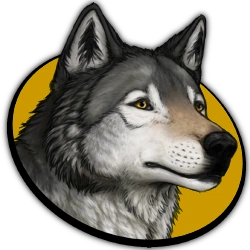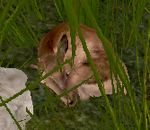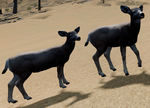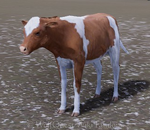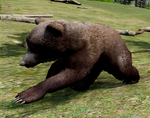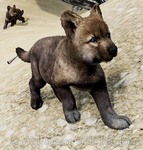 |
This To-do: restructure into a format similar to Carcass. is need of a clean-up. You can help out the WolfQuest Wiki by re-organizing parts of the article, checking grammar and spelling, and doing other helpful things to correct the article.
|
Juveniles are young, immature animals which have not yet reached their adult stages of growth. They may seem like easy targets, however, players are urged to be cautious — where there's a young and vulnerable creature, it is likely to be protected by its mother... or something else far more dangerous! The implementation differs significantly between all revisions of WolfQuest.
In WolfQuest: Anniversary Edition, a much wider variety of juvenile animals make their debut along with some much-needed improvements over its predecessors. While they may be vulnerable and seem like an easy meal at first glance, don't be deceived! Some are quick and agile, effortlessly capable of keeping up with their adult counterparts. Others are slow; there are those who will flee and those who will stand their ground all by themselves. Certain life stages will hide until they find their feet; others will learn quickly shortly after birth and stay in plain sight.
The majority of juveniles have the added benefit of their mother's watchful gaze and fierce protection. The player-wolf will need to tread carefully and find the right strategy if they are to successfully hunt young prey or harass young predators!In WolfQuest: Classic, aside from some improvements and changes, this game's selection of juveniles is relatively unchanged from the Legacy era. There are no new juveniles nor any new life stages for existing juveniles.
Prey
This section lists prey juvenile animals. The player-wolf can hunt these for a chance of scoring an easier meal which — depending on the season and the animal's age — may be carried. Juveniles make an acceptable snack for all predators including wolves and their packmates. Offered to growing pups, carcasses of all ages offer a substantial meal.
Packs composed of adults benefits very little from juvenile carcasses in the long term and would fare better from mature ungulate carcasses.
Moose
- Main article: Moose calf#Anniversary Edition
In the Anniversary Edition, moose calves have two distinct stages of maturity in the current game. They lack distinctive genders until mature.
- Newborn calves are born in May-June.[1] They are mobile shortly after birth, and will stay close to their mother's side as she roams and grazes. They do not hide in clumps of tall grass. Their appearance remains the same throughout the summer. This stage of growth is always compact enough to be carried as a carcass.
- Fall calf is the second and final stage of maturity. Their coats have finished developing, and they appear to be a downscaled version of the adult cow moose model. They will still be protected by their mother.
In Classic, there are no moose calves.
In Legacy versions, there are no moose.
Elk
- Main article: Elk calf#Anniversary Edition
In the Anniversary Edition, elk calves have three distinct stages of maturity in the current game. They lack distinctive genders until mature.
- Newborn calves are born in May-June.[2] Come early summer, they will be hidden in clumps of tall grass while their mother grazes nearby. Alone, and unprotected by their herd, newborn calves are scentless and extremely vulnerable. During this time, it and its mother exist in their own solitary "Mother and Baby" herd.
- Summer calf is the second stage of maturity. They are mobile, their coats have some spotting, and are ready to flee during the mid-summer period. They are protected both by their mother and by their full herd.
- Fall calf is the third and final stage of maturity. Their coats have finished developing, and they appear to be a downscaled version of the adult cow elk model. They will still be protected by their mother and herd, and continue to persist through the winter.
Spikes are the 1-2 year old equivalent of bull elk. They are the previous year's maturing male calves.
The carcass of a newborn is compact enough to be carried when killed. However, the mid-summer, fall, and winter stages of growth are too heavy and cannot be carried when killed.In Classic, there are no elk calves.
In Legacy versions, there are no elk calves.
Pronghorn
- Main article: Pronghorn fawn#Anniversary Edition
In the Anniversary Edition, pronghorn fawns have three distinct stages of maturity in the current game. They lack distinctive genders until mature.
- Newborn fawns are born in late May-early June.[3] Come early summer, they will be hidden in clumps of tall grass while their mother grazes nearby. Newborn fawns are extremely vulnerable and scentless.
- Summer fawn is the second stage of maturity. They are mobile and ready to flee during the mid-summer period.
- Fall fawn is the third and final stage of maturity. Their coats have finished developing, and they appear to be a downscaled version of the adult doe pronghorn model. They will still be protected by their mother.
In Classic, there are no pronghorns.
In Legacy versions, there are no pronghorns.
Mule deer
- Main article: Mule deer fawn#Anniversary Edition
Mule deer fawns have three distinct stages of maturity in the current game. They lack distinctive genders until mature.
- Newborn fawns are born in late May-early August.[4] Come early summer, they will be hidden in clumps of tall grass while their mother grazes nearby. Newborn fawns are extremely vulnerable and scentless.
- Summer fawn is the second stage of maturity. They are mobile and ready to flee during the mid-summer period.
- Fall fawn is the third and final stage of maturity. Their coats have finished developing, and they appear to be a downscaled version of the adult doe mule deer model. They will still be protected by their mother.
In Classic, there are no mule deer.
In Legacy versions, there are no mule deer.
Livestock
Animals reared by humans are a potential target for hungry wild wolves. However, hunting them is not without its risks.
Domestic Cattle
- Main article: Cattle calf (livestock)#Anniversary Edition
In the Anniversary Edition, cattle calves are returning prey re-introduced into the modern game as of 1.0.9. They can only be found in the expanded Lost River in an isolated livestock ranch where they may only be hunted at night.
The carcass of a cattle calf is too heavy and cannot be carried when killed. This restriction applies year-round.
- Main article: Cattle calf (livestock)#Classic

A cow/cattle calf.
- Main article: Cattle calf (livestock)#Legacy

A cow calf.
Predators
This section lists predator juvenile animals — those who will grow up to compete against the player-wolf and their pack over food, and those who will only compete for territory and food. Just like their fully-matured counterparts, there is nothing to gain from harassing or killing predator offspring. They may, however, be observed from a safe distance to witness various interactions and activities amongst themselves.
Grizzly bear
- Main article: Grizzly bear cub
In the Anniversary Edition, grizzly cubs have two distinct stages of maturity in the current game. They lack distinctive genders until mature.
- Newborn grizzly cubs are born in late January- early February.[5] Because they are born during the winter hibernation period, their newborn phase is not depicted in-game.
- Spring cub is the first stage of maturity. Emerging from their hibernal den with their mother and any surviving siblings in the spring, they wander, feast, and rest together in their small family groups.
- Fall cub is the second and final stage of maturity. Their coats have finished developing, and they appear to be a downscaled version of the adult model.
In Classic, there are no grizzly cubs.
In Legacy versions, there are no grizzly cubs.
Wolves
Gray wolf
- Main article: Gray wolf pup#Anniversary Edition
In the Anniversary Edition, gray wolf pups are base game juveniles native to the Yellowstone and mountain west ecosystems. They have three distinct stages of maturity in the current game, with one distinct and two subtle stages of maturity coming in the future. They lack distinctive genders until mature.
- Newborn gray wolf pups are born in April.[6] They are born blind and deaf, and stay inside the den site for their first four weeks of life.
- 1-month-old is the first stage of maturity. Pups emerge from the den for the first time. They are vulnerable and rely heavily on their parents for food (regurgitant), protection, and interaction. By mid-summer, they can eat from carcasses and meat chunks.
- 2-3 months-old is the second (and currently final) stage of maturity. Pups leave the den for the last time, and the pack moves to a rendezvous site. Pups use clumps of tall grass to hide in and sleep in.
- 4-months-old? up to yearling are expected to appear in the upcoming WolfQuest Saga update.
- NPC adolescents up to fully-mature adults (non-dispersers and dispersers) are expected to appear in the upcoming Saga update.
Only the player's own pack will have pups in-game during the second chapter of the main campaign in single-player, or during the multiplayer Raise Pups co-operative game type.
NPC rival packs do not have any implementation of young vulnerable offspring to protect, nor will rivals be seen denning-down or using rendezvous sites. It is unknown if this will change.
- Main article: Gray wolf pup#Classic

4-weeks-old gray wolf pup.
- Main article: Gray wolf pup#Legacy

4-weeks-old gray wolf pup.
Trivia
Anniversary Edition Trivia
- Although it is not possible to have pups outside of the Raise Pups mode of multiplayer or define an avatar's life stage (with common examples being pup, yearling, sub-adult and elder) it is not uncommon to find players roleplaying this life stage despite their avatar's obvious adult age and size.
Classic Trivia
- Although it is not possible to have pups outside of the Raise Pups mode of multiplayer or define an avatar's life stage (with common examples being pup, yearling, sub-adult and elder) it is not uncommon to find players roleplaying this life stage despite their avatar's obvious adult age and size.
- Cattle calves, along with wolf pups, were the first juvenile animals introduced in WolfQuest in 2010.
Classic and Legacy Trivia
- The cattle ranch is also completely inaccessible in multiplayer, rendering the cattle calf a single-player-only entity.
Legacy Trivia
References & External Links
- ↑ Moose in Yellowstone National Park, Moose - Yellowstone National Park (U.S. National Park Service)
- ↑ Baby Animals of Yellowstone - Elk, Elk - Yellowstone National Park (U.S. National Park Service)
- ↑ Pronghorn - Wikipedia
- ↑ Finding Mule Deer in Yellowstone, Mule Deer - Yellowstone National Park (U.S. National Park Service)
- ↑ Grizzly Bear | National Wildlife Federation, Grizzly Bear - Yellowstone National Park (U.S. National Park Service), Denning and Hibernation Behavior - NPS
- ↑ Gray Wolf - Yellowstone National Park (U.S. National Park Service)
- ↑ wolfquest.org • Summertime Snack
| NPCs | ||||
|---|---|---|---|---|
| Competitors & Predators | Bald eagle • Bobcat • Black bear • Cougar • Coyote • Dog • Golden eagle • Grizzly bear • Raven • Red fox | |||
| Prey | Beaver • Bighorn sheep • Bison • Domestic cattle • Elk • Moose • Mule deer • Porcupine • Pronghorn • Snowshoe hare | |||
| Newborns & Juveniles | Bighorn sheep lamb • Domestic cattle calf • Elk calf • Grizzly bear cub • Moose calf • Mule deer fawn • Pronghorn fawn | |||
| Wolves | Dispersal (Mate) • Offspring: Pup, Yearling, Adult, Disperser • Predator • Stranger | |||
| Non-interactable | Birds • Cat • Insect | |||
| Non-entity | Human | |||
| Miscellaneous | Airplane • Amphibians • Fish • Herds • Wolf Packs | |||
